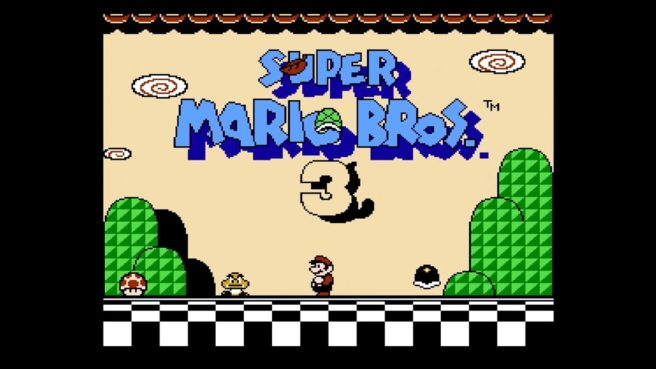Miyamoto, Tezuka, Kondo on Super Mario Bros. 3 – scrapped overhead perspective, power-ups, music, more
Wanting people to save like crazy
So, everyone can play both the original Super Mario Bros as well as the human wave-supported 3 on the Classic Mini. What would you like people to experience while playing them, Mr. Kondo?
Kondo: Even though both games were developed for the Famicom, there was a huge difference in the types of sounds they could produce, so I would like people to compare how the two of them sound.
What specifically would you be comparing?
Kondo: Although the original Famicom had a special sample-based sound chip, it required a lot of memory on the cartridge. When we were developing Super Mario Bros 3, we had access to more advanced cartridges with much greater memory capacity, so we finally had enough space to use the samples, things like percussion and timpanis. So 3’s compositions sound a lot more pleasant than the first game’s.
Since both games are included, it will be easy for people to compare them.
Kondo: That’s right.
What are you looking forward to, Mr. Tezuka?
Tezuka: I’m looking forward to having people enjoy the nostalgia they hold for the games. Especially Super Mario Bros 3, which had very many courses. When people finish one, they say “okay, next” and jump to the next stage immediately.
So people rush through the game.
Tezuka: But we crammed all sorts of things for people to find into every single stage, so you could replay the same one over and over and still find new ways to do things.
Of course, you spent so long working on the game after all (laughs).
Tezuka: Yes(laughs). I wanted people to try completing the stages in many different ways, like defeating all of the enemies. Things like that.
And finally, Mr. Miyamoto, how about you?
Miyamoto: You couldn’t save your game in Super Mario Bros 3, so there were many people back then who would worry about losing their progress, and just keep the console running constantly. (laughs)
There were (laughs).
Miyamoto: But this time, there are four save slots. All thirty games on the Mini have four save slots each.
So you can keep a save right before your favorite part.
Miyamoto: I hope that people can find relief from those bad memories, and save like crazy.
Packed with over ten years of history
All things considered, the Famicom hardware remained relevant for quite a long time. The Classic Mini includes Donkey Kong, which was released in 1983 alongside the console, and Kirby’s Dreamland(*7), the final title to come out in 1993. So it’s packed with over ten years of history.
*7 – Kirby’s Dreamland = Action game released for the Famicom in March of 1993.
Miyamoto: That’s right.
Why do you think the Famicom was able to last for over ten years?
Miyamoto: I think a big part of its success is related to what Mr. Kondo discussed a little while ago, how the game cartridge technology kept evolving.
The console remained the same, but the cartridges became more and more advanced, allowing you to create fresh gaming experiences.
Miyamoto: That’s right. And it was also helped along by all of the interesting people who would show up to develop games for us, and who kept their creativity flowing.
People who weren’t part of the game industry, like Mr. Shigesato Itoi(*8), would join and start making their own games.
*8 – Shigesato Itoi: Copywriter and essayist, among many other things. Developed many games, including MOTHER and Shigesato Itoi’s No. 1 Bass Fishing. Now the editor-in-chief of the ‘Almost’ Daily Itoi News.
Miyamoto: That’s correct.
So even though Super Mario Bros was intended to be the last cartridge release, and be phased out in favor of the Disc System, it ended up selling like hotcakes…
Miyamoto: Consoles sales skyrocketed after that. The NES(*9) also came out in America after Super Mario Bros had in Japan.
*9 – NES: Nintendo Entertainment System, the name given to the Famicom overseas. Released on October 18th, 1985 in America.
The console came out two years later in the United States compared to Japan. So even though you considered Super Mario Bros the ‘grand finale of Famicom carts’, the reality was, things were just getting started.
Miyamoto: That’s right. After Super Mario Bros, I was able to meet with all sorts of different people and experience many new things. Recently, I stood on stage at Apple’s presentation(*10), to the excitement of many people (laughs). And that’s all thanks to Mario, who’s like an older brother to me [now].
*10 – Apple’s presentation: Presentation held by Apple in San Francisco during September of 2016. Miyamoto appeared during the conference to/and announce[d] that Super Mario Run would launch in December of 2016.
Massive thanks goes out to Gessenkou and iYakku for their assistance with this translation!
Thanks for making it to the end of this post! If you use any of this translation, please be sure to properly source Nintendo Everything. Do not copy its full contents.
